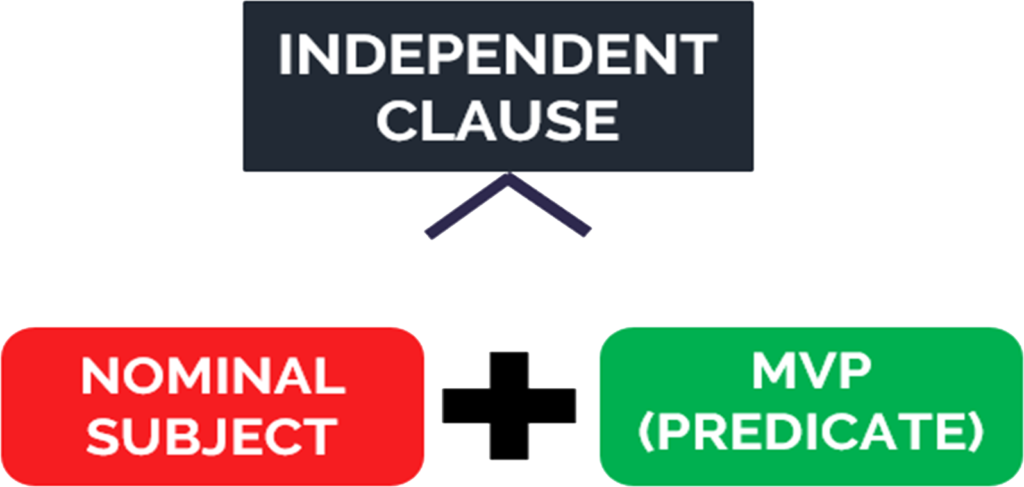chapter 6: independent clauses
An independent clause is a clause that is able to stand alone as a sentence and is NOT preceded by a dependent marker.

For an independent clause, the subject is the first element in the clause, with no dependent marker preceding it.
Keep in mind that words like an adverb, an adverbial phrase, or a coordinating conjunction, for example, may precede the subject of an independent clause, but these words are NOT a dependent marker. Remember that adverbials are always optional. For example, let’s examine these three clauses.
Margot’s mind reeled, and she could hear the listless, scraping sounds of fingertips against the door. Consequently, It haunted her to consider the sea of faces outside.
- Margot’s mind reeled
- and she could hear the listless, scraping sounds of fingertips against the door
- Consequently, it haunted her to consider the sea of faces outside
Each of these clauses is an independent clause. As always, we begin our analysis of clauses by identifying the Main Verb Phrase of each clause. Then the next step is to identify if there are any dependent markers. In this example, there are no dependent markers present.
- In the first clause, the subject is MARGOT’S MIND. Nothing precedes the subject, for MARGOT’S is a possessive determiner. It is NOT a dependent marker.
- In the second clause, AND precedes the subject, SHE, but AND is a coordinating conjunction. Coordinating conjunctions are never dependent markers. Remember, coordinating conjunctions always coordinate like items. In this case, AND is coordinating two independent clauses.
- In the third clause, CONSEQUENTLY precedes the subject, IT, but CONSEQUENTLY is an adverb, not a dependent marker. Another clear indicator that CONSEQUENTLY is not a dependent marker is the comma between it and the subject. A dependent marker can never be separated from its subject.
An independent clause can only function as an independent clause, so its form and function are always INDEPENDENT CLAUSE.
While most independent clauses are declaratives, there are two “other” independent clauses that you should be able to account for in your analysis: questions and imperatives.
As we stated earlier, this is not a syntax textbook, but we do need to point out that both questions and imperatives are created through transformation, whereby declarative clauses, as the deep meaning, have become either a question or a command. While we will give you a very basic primer on question and imperative transformations, we are really only interested in you recognizing questions and imperatives as independent clauses.
Questions are also known as interrogatives, but in this textbook we call them QUESTIONS so as not to confuse them with interrogative clauses. As a brief primer, we will describe two types of questions:
- yes/no questions
- wh- questions
The yes/no question transformation includes two steps:
- In a declarative clause, if there is no auxiliary verb or BE, insert DO as an auxiliary verb.
- Move the first auxiliary verb or BE to the front of the sentence.
- Henry is waiting outside.
- Is Henry waiting outside?
- Cara has a new basketball.
- Does Cara have a new basketball?
The wh- question transformation includes four steps:
- If the unknown is not the subject and if there is no auxiliary verb or be, insert DO as an auxiliary verb.
- Move the first auxiliary verb or the main verb, if there is no auxiliary verb, to the front of the sentence.
- Substitute an appropriate interrogative word for the constituent representing unknown information.
- Move the interrogative word to the front of the sentence.
- Celia played a solo.
- played Celia a solo
- played who a solo
- Who played a solo?
The KEY MARKER for questions is, obviously, the QUESTION MARK at the end of the clause.
Imperative sentences give commands and issue orders. The imperative transformation contains two steps:
- Delete the subject you from a declarative sentence that contains no auxiliary verbs.
- Delete TENSE from the AUX, leaving the base form of the verb.
- You walk faster.
- Walk faster!
- You give her your ice cream.
- Give her your ice cream!
This is the only independent clause in this course with an implied subject. And while the key marker for the imperative is the exclamation point at the end of the clause, be careful not to confuse an inadvertent sentence fragment with the stylistic choice made to use an imperative. A sentence fragment is NOT an imperative.
Again, the key is not that you can analyze and describe the transformations, but that you recognize questions and imperatives as independent clauses.
Remember, the key is, first, to identify the main verb phrase so that you know that it is a clause, and, second, to determine if a dependent marker is present or not. As we will discuss in the upcoming pages, dependent markers are a relatively closed list, so familiarize yourself with these words so that you can recognize them quickly and easily. An independent clause begins with the subject, so begin to recognize the difference between an adverbial phrase, which can be moved or deleted, and a dependent marker.

